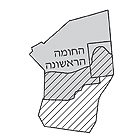Second Temple Period >> Hasmonean Period, Fourth Century BCE until 37 BCE
|

|
At the time of the Maccabean revolt (167 BCE) the city was small and it covered the same area as it did during the time of Nehemiah. The city’s expansion to the west, to areas that were previously inhabited, probably started at the beginning of the second century BCE. It was during this period that the city wall, which Josephus dubs the ‘Old Wall’, was built.
The construction style of the Hasmonean wall is irregular and it seems that it was erected in stages by different builders over a long period of time. At first the wall was built on the western side of the hill; the eastern side was naturally protected by a cliff that was hewn vertical. Later the southern part of the wall was built from the Shiloah Pool. Remains of the city wall from the First Temple period are incorporated in this wall.
The spread of the city to the west and the transfer of its center to this region occurred because of two important reasons: the extremely crowded conditions in the City of David and the desire to establish a Hellenistic city. Numerous changes were implemented in the area of the Temple Mount during this period, among them the construction of the ‘Acra’ (‘the high place’, ‘fortress’) etc.
Finds:
Remains of the first wall that the Hasmoneans built have been found, including impressive sections that are integrated in the eastern wall of the Temple Mount.
Historical Sources:
Descriptions of the city walls in Josephus. Book of the Maccabees.
Remarks:
Most of the city's buildings from the Hasmonean period were destroyed. This probably happened during the Herodian building period which required deep foundations for its structures.
|
|

| The city wall in the Hasmonean period |
|















